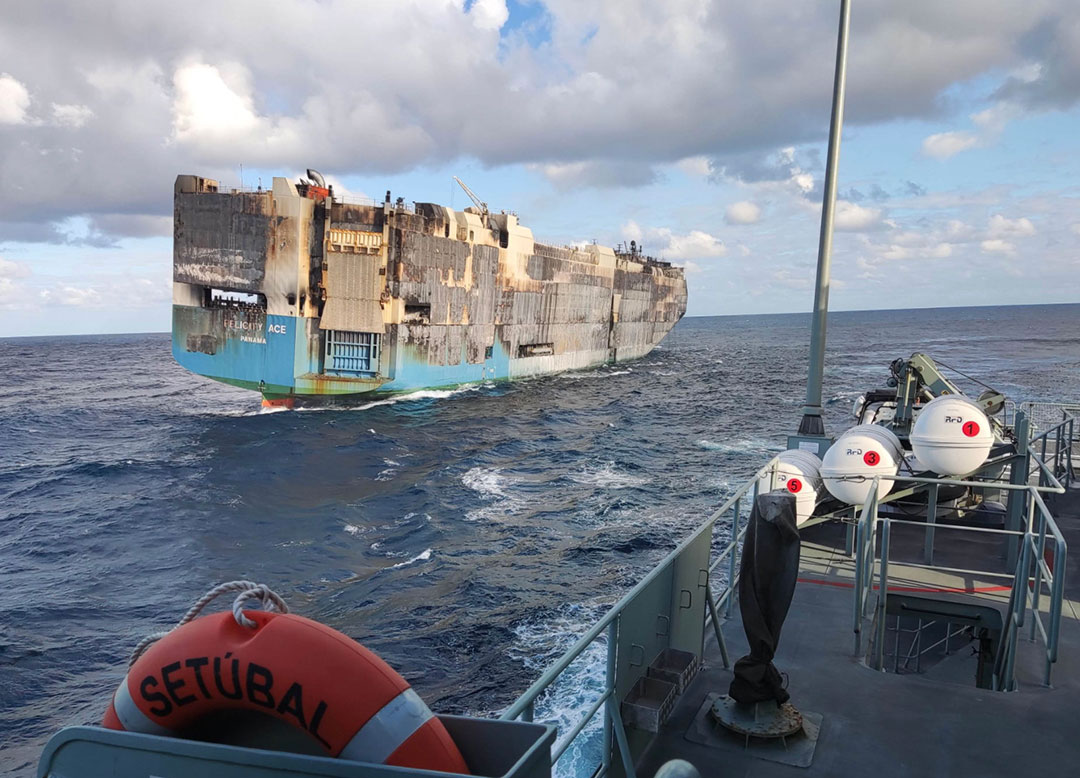
A vehicle carrier loaded with European automobiles caught fire and later sank in the Atlantic Ocean while under tow toward the Azores.
The fire aboard the 656-foot Felicity Ace started at about 0930 local time on Feb. 16 while the vessel was about 90 nautical miles southwest of the Azores. The captain ordered the 22 crewmembers to abandon ship later that day, and they were later taken to Faial Island in the Azores.
The Panama-flagged ship remained on fire until about Feb. 25, when smoke was no longer visible. It sank on March 1 while under tow by the oceangoing tugboat Bear.
“Today … the ship Felicity Ace lost stability (and) sank about 25 nautical miles outside the Economic Exclusion Zone of Portugal,” the Portuguese navy said March 1 in a statement posted to social media.
Felicity Ace was en route from Emden, Germany, where Volkswagen Group has a plant, to Davisville, R.I., when the fire started. The ship was carrying nearly 4,000 vehicles, including more than 1,000 Porsches, nearly 200 Bentleys and numerous Lamborghinis, according to published reports. The entire load of vehicles was reportedly worth about $400 million.
The cause of the fire is not known, and it is not clear which country is leading an investigation. Public statements from local Portuguese officials suggested lithium-ion car batteries contributed to the severity and duration of the fire, although that could not be independently confirmed.
The 17-year-old Felicity Ace was owned by Snowscape Car Carriers S.A., a subsidiary of Tokyo-based Mitsui O.S.K. Lines, or MOL. It was managed by MOL Ship Management Pte. Ltd. of Singapore.
MOL issued a series of statements on a dedicated website as the incident unfolded. The company described the captain’s decision to abandon ship as “prudent.” Details about the evacuation were not available, although the company said the 22 crewmembers reached shore “with assistance from commercial ships and (a) helicopter in the area.”
“Mitsui O.S.K. Lines wishes to thank the Portuguese navy, the local authorities in the Azores and those vessels that supported the rescue operation of the crewmembers in the best traditions of the merchant marine,” MOL said on Feb. 18.
Portugal’s navy dispatched a warship that stood by as Felicity Ace drifted away from the Azores. Meanwhile, the tugboats ALP Guard and Dian Kingdom reached the ship on Feb. 21 and began spraying water on the hull “to achieve boundary and hull cooling,” MOL officials said.
The salvage ship VB Hispania and Bear arrived on Feb. 24. Smoke emanating from the burning ship began to subside that day. The following day there was no smoke coming from the vessel.
“The salvage team on site (was) able to board Felicity Ace by a helicopter and the vessel has started being towed by the large salvage craft Bear to a safe area off Azores,” MOL said on Feb. 25.
Four days later, the ship sank in almost 10,000 feet of water about 220 nautical miles from the Azores. According to MOL, the vessel developed a starboard list during the tow and sank at about 0900.
Debris and a small oily sheen were all that was left of the ship, the Portuguese navy said. Tugboats assisting with the salvage used propeller wash to break up the sheen.
Fires aboard vehicle carriers can spread quickly and bring serious consequences. Five crewmembers were lost in the Pacific Ocean during a harried evacuation of the burning Sincerity Ace in late 2018. The fire started when the ship was roughly 1,800 nautical miles northwest of Honolulu, Hawaii.
The June 2020 fire that started aboard the car carrier Hoegh Xiamen at the dock in Jacksonville, Fla., took nearly a week to extinguish. Nine local firefighters were injured fighting the flames. The National Transportation Safety Board in December announced the fire likely started from an electrical fault in an improperly connected battery cable in one of the vehicles.
The Port of Davisville is located on the west side of Narragansett Bay in North Kingstown, R.I. It had 224 ship calls and 300,000 auto imports in 2019, the last full year before the Covid-19 pandemic. Imports fell by about 17 percent to 250,000 vehicles during 2020, and 2021 data is not yet available. The port is one of the top 10 in the United States for motor vehicle imports. •
